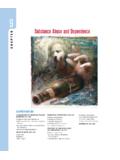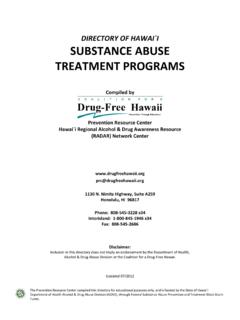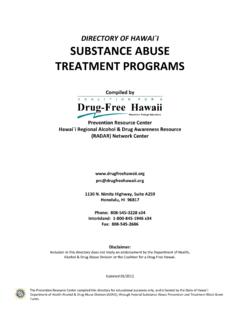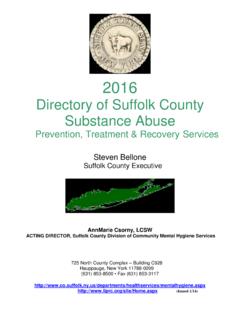Transcription of Neuroscience of psychoactive substance use and …
1 Neuroscience of psychoactivesubstance use and dependenceThe Neuroscience of psychoactive substance use and dependenceprovides an authoritative summary of current knowledge of thebiological basis of substance use and dependence , and discus-ses the relationship of these behaviours with environmental fac-tors. The book focuses on specific brain mechanisms governingcraving, tolerance, withdrawal, and dependence on a wide rangeof psychoactive substances, including tobacco, alcohol and illicitdrugs. The ethical implications of new developments for preven-tion and treatment are also discussed, and the public healthimplications of this knowledge are translated into recommenda-tions for policy and programmes at national and internationallevels. Relying on contributions from many international experts,the best available evidence is presented from the various schoolsof thought and areas of research in this rapidly growing of psychoactive substance use and dependenceiswritten for individuals with more than a basic knowledge of thefield, including scientists from a variety of disciplines.
2 The bookshould be of interest to health care workers, clinicians, socialworkers, university students, science teachers and policy 92 4 156235 8 Neuroscience of psychoactive substance use and dependenceWHODepNeuroCoverFinal_CAG 12:15 Page 1 Neuroscience ofpsychoactive substance useand dependenceWORLD HEALTH , 12:361 World Health Organization 2004 All rights reserved. Publications of the World Health Organization can be obtained from Marketingand Dissemination, World Health Organization, 20 Avenue Appia, 1211 Geneva 27, Switzerland(tel: +41 22 791 2476; fax: +41 22 791 4857; email: Requests forpermission to reproduce or translate WHO publications whether for sale or for noncommercialdistribution should be addressed to Publications, at the above address (fax: +41 22 791 4806.))
3 Email: designations employed and the presentation of the material in this publication do not implythe expression of any opinion whatsoever on the part of the World Health Organization concerningthe legal status of any country, territory, city or area or of its authorities, or concerning thedelimitation of its frontiers or boundaries. Dotted lines on maps represent approximate borderlines for which there may not yet be full mention of specific companies or of certain manufacturers products does not imply thatthey are endorsed or recommended by the World Health Organization in preference to others ofa similar nature that are not mentioned. Errors and omissions excepted, the names of proprietaryproducts are distinguished by initial capital design by minimum graphicsCover design by Tushita Graphic VisionPrinted in SwitzerlandWHO Library Cataloguing-in-Publication DataNeuroscience of psychoactive substance use and Psychotropic drugs - pharmacology2.
4 substance -related disorders -physiopathology3. Psychopharmacology4. Brain - drug effectsI. World Health Organization. ISBN 92 4 156235 8(LC/NLM classification: WM 270) , 12:362 ContentsForewordixAcknowledgementsxiList of background papers and contributorsxvAbbreviationsxviiChapter 1. Introduction1 Structure of the report1 psychoactive substances and their sociolegal status1 Global use of psychoactive substances4 Tobacco4 Alcohol5 Illicit use of controlled substances9 Adverse effects of psychoactive substances and their mechanismsof action10 substance dependence in relation to neuroscience12 The burden of harm to health from psychoactive substance use16 Chapter 2. Brain Mechanisms: Neurobiology and Neuroanatomy19 Introduction19 Organization of the brain19 The neuron25 Cell body26 Dendrites26 Axon28 Terminal buttons28 Neurotransmission29 Action potential29 Neurotransmitter release30 Receptors31 Neurotransmitters32 Acetylcholine33 -aminobutyric , 12:363 Neuroscience OF psychoactive substance USE AND DEPENDENCEivSerotonin35 Peptides35 Genes35 Cellular and neuronal effects of psychoactive substances36 Cellular effects36 Neuronal effects38 Conclusion39 Chapter 3.
5 Biobehavioural Processes Underlying Dependence43 Introduction43 Defining terms44 Classical or Pavlovian conditioning44 Instrumental or operant conditioning46 Reinforcer47 Reward47 Incentive47 Motivation48 Incentive-motivational responding48 Drug reward alone does not explain drug dependence48 Drug dependence as a response to incentive-motivation49 Drug dependence as a response to drug withdrawal50 Dopamine and reinforcement learning50 dependence -producing drugs as surrogates of conventionalreinforcers51 Dopamine and incentive sensitization52 Psychomotor sensitization53 Sensitization and drug reward53 Sensitization and tolerance54 Individual differences55 Summary58 Chapter 4. Psychopharmacology of dependence for DifferentDrug Classes67 Introduction67 Alcohol (ethanol)69 Introduction69 Behavioural effects69 Mechanism of action70 Tolerance and withdrawal70 Neurobiological adaptations to prolonged use72 Pharmacological treatment of alcohol dependence72 Sedatives and hypnotics73 Introduction73 Behavioural effects73 Mechanism of , 12.
6 364vTolerance and withdrawal74 Neurobiological adaptations to prolonged use75 Tobacco75 Introduction75 Behavioural effects75 Mechanism of action76 Tolerance and withdrawal77 Pharmacological treatment of nicotine dependence78 Opioids79 Introduction79 Behavioural effects79 Mechanism of action80 Tolerance and withdrawal80 Neurobiological adaptations to prolonged use81 Pharmacological treatment of opioid dependence81 Cannabinoids84 Introduction84 Behavioural effects85 Mechanism of action86 Tolerance and withdrawal87 Neurobiological adaptations to prolonged use88 Cocaine (hydrochloride and crack)89 Introduction89 Behavioural effects89 Mechanism of action89 Tolerance and withdrawal91 Neurobiological adaptations to prolonged use91 Pharmacological treatment of cocaine dependence92 Amphetamines93 Introduction93 Behavioural effects94 Mechanism of action95 Tolerance and withdrawal95 Neurobiological adaptations to prolonged use96 Ecstasy96 Introduction96 Behavioural effects99 Mechanism of action99 Tolerance and withdrawal100 Neurobiological adaptations to prolonged use100 Volatile solvents100 Introduction100 Behavioural effects101 Mechanism of , 12.
7 365 Neuroscience OF psychoactive substance USE AND DEPENDENCEviTolerance and withdrawal103 Neurobiological adaptations to prolonged use103 Hallucinogens104 Introduction104 Behavioural effects105 Mechanism of action105 Tolerance and withdrawal105 Neurobiological adaptations to prolonged use106 Summary106 Chapter 5. Genetic Basis of substance Dependence125 Introduction125 Family, twin and adoption studies: estimations of heritability127 Identifying chromosomal locations of interest: linkage studies127 Candidate gene approach128 Animal studies128 Genetics of tobacco dependence130 Heritability of tobacco dependence130 Tobacco dependence and linkage studies131 Candidate genes for tobacco dependence131 Genetics of alcohol dependence132 Heritability of alcohol dependence132 Alcohol dependence and linkage studies133 Candidate genes for alcohol dependence134 Genetics of opioid dependence136 Heritability of opioid dependence136 Opioid dependence and linkage studies136 Candidate genes for opioid dependence136 Genetics of the combined risk of dependence on tobacco, alcohol.
8 Opioids and other psychoactive substances138 Heritability of substance dependence138 Linkage studies of substance dependence139 Candidate genes involved in substance dependence140 Confounding issues in linkage and candidate gene studies147 Environment147 Genetice heterogeneity147 Phenotype148 Comorbidity148 Methodological issues148 Future directions149 Social and cultural aspects150 Risk factors and protective factors for dependence : an , 12:366viiChapter 6. Concurrent Disorders169 Introduction169 Hypotheses that may explain the observed comorbidity170 Schizophrenia171 Tobacco smoking and schizophrenia171 Psychostimulant (cocaine and amphetamine) dependence andschizophrenia174 Alcohol use and schizophrenia176 Neurobiological interactions between schizophrenia and the effectsof psychoactive substances176 Depression180 Tobacco smoking and depression181 Psychostimulant dependence and depression182 Alcohol use and depression183 Neurobiological interactions between depression and the effectsof psychoactive substances184 Discussion and conclusions188 Chapter 7.
9 Ethical Issues in Neuroscience Research on SubstanceDependence Treatment and Prevention209 Introduction209 Types of research on Neuroscience of substance dependence209 Animal experiments209 Epidemiological research on substance dependence209 Experimental studies in humans210 Clinical trials of pharmacotherapy for substance dependence210 Trials of pharmacotherapies to prevent substance dependence211 Approach to ethical analysis211 Principles of biomedical ethics216 Human rights217 Ethics of animal experimentation in Neuroscience research218 Ethical principles in human biomedical research219 Independent ethical review of risks and benefits219 Informed consent220 Recruitment of subjects220 Privacy and confidentiality221 Emerging ethical issues in Neuroscience research222 Research on vulnerable persons222 Are substance dependent people vulnerable persons?
10 223 Provocation studies223 Ethical issues in epidemiological research on substance dependence224 Ethical issues in clinical trials of pharmacological treatmentsfor substance dependence225 Trial , 12:367 Neuroscience OF psychoactive substance USE AND dependence viiiDistributive justice226 Conflicts of interest226 Trials of preventive pharmacological interventions for substancedependence227 Early intervention studies227 Preventive use of drug immunotherapies229 Implications of Neuroscience research for models of substancedependence231 Implications of Neuroscience research for the treatment of substancedependence232 Access to treatment232 Legally coerced treatment232 Summary and conclusions235 Chapter 8. Conclusion and Implications for Public Health Policy241 Introduction241 Advances in the Neuroscience of psychoactive substance use anddependence and their implications241 Potential advances in policy, prevention and treatment243 Ethical issues in the application of Neuroscience findings244 Implications for public health , 12:368ixForewordSubstance use and dependence cause a significant burden to individuals andsocieties throughout the world.
















